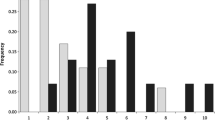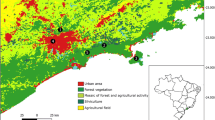Abstract
The salt marsh horse fly, Tabanus nigrovittatusMacquart, exhibits two nonoverlapping daily periods of hovering and mating activity, which are correlated with different environmental temperatures. Allelic and genotypic frequencies of hovering males collected during the two periods were compared by electrophoresis of three polymorphic enzyme loci. Approximately 26% of early-hovering males possessed a Pgmallozyme that was absent in our sample of late-hovering males. However, based on other allozyme loci, we found no evidence for reproductive isolation between early and late hoverers. All the genetic data are consistent with the hypothesis that the Pgmpolymorphism is associated with behaviorally and physiologically distinct groups of males that, by all other criteria, form a single Mendelian population.
Similar content being viewed by others
References
Downes, J. A. (1969). The swarming and mating flight of Diptera.Annu. Rev. Entomol. 14: 271–298.
Gaugler, R., and Schutz, S. J. (1989). Environmental influences on hovering behavior ofTabanus nigrovittatus andT. conterminus (Diptera: Tabanidae).J. Insect Behav. 2: 775–786.
Hudson, A., and Tesky, H. J. (1976). Morphological and biochemical characteristics of two forms ofHybomitra typhus (Diptera: Tabanidae).Can. Entomol. 108: 737–740.
Jacobson, N. R., Hansens, E. J., Vrijenhoek, R. C., Swofford, D. L., and Berlocher, S. H. (1981). Electrophoretic detection of a sibling species of the salt marsh greenhead,Tabanus nigrovittatus.Ann. Entomol. Soc. Am. 74: 602–605.
Matsumura, T., and Shiyomi, N. (1987). Factors relative to the hovering time ofTabanus rufidens.Kontyu 55: 559–560.
Place, A. R., and Powers, D. A. (1979). Genetic variation and relative catalytic efficiencies: Lactate dehydrogenase B allozyme ofFundulus heteroclitus.Proc. Natl. Acad. Sci. 76: 2354–2358.
Ridgeway, G. J., Sherbourne, S. W., and Lewis, S. D. (1970). Polymorphism in the esterase of Atlantic herring.Trans. Am. Fish. Soc. 99: 147–151.
Sacktor, B. (1975). Biochemistry of insect flight. 1. Utilization of fuels by muscle. In Candy, D. J., and Kilby, B. A. (eds.),Insect Biochemistry and Function, Chapman and Hall, London, pp. 1–88.
Schutz, S. J., and Gaugler, R. (1990). Thermoregulation and hovering behavior of salt marsh horse flies (Diptera: Tabanidae) (submitted for publication).
Schutz, S. J., Gaugler, R., and Vrijenhoek, R. C. (1989). Genetic and morphometric discrimination of coastal and inlandTabanus lineola (Diptera: Tabanidae).Ann. Emomol. Soc. Am. 82: 220–224.
Shaw, C. R., and Prasad, R. (1970). Starch gel electrophoresis: A compilation of recipes.Biochem. Genet. 4: 297–320.
Sofield, R. K., Buroker, N. E., Hansens, E. J., and Vrijenhoek, R. C., (1984a). Genetic diversity within and between sibling-species of salt marsh horseflies (Diptera: Tabanidae).Ann. Emomol Soc. Am. 77: 663–668.
Sofield, R. K., Douglas, M. E., Hansens, E. J., and Vrijenhoek, R. C., (1984b). Diagnosis and detection of cryptic species: TheTabanus nigrovittatus complex (Diptera: Tabanidae) in coastal New Jersey.Ann. Entomol. Soc. Am. 77: 587–591.
Thomhill, R., and Alcock, J. (1983).The Evolution of Insect Mating Systems, Harvard University Press, Cambridge, Mass.
van Delden, W., Boerema, A. C., and Kamping, A. (1978). The alcohol dehydrogenase polymorphism in populations ofDrosophila melanogaster. I. Selection in different environments.Genetics 90: 161–191.
Watt, W. B. (1985). Bioenergetics and evolutionary genetics: Opportunities for a new synthesis.Am. Nat. 125: 118–143.
Watt, W. B., Cassin, R. C., and Swan, M. S. (1983). Adaptation at specific loci. III. Field behavior and survivorship differences amongColias PGI genotypes are predictable from in vitro biochemistry.Genetics 103: 725–739.
Watt, W. B., Carter, P. A., and Blower, S. M. (1985). Adaptation at specific loci. IV. Differential mating success among glycolytic allozyme genotypes ofColias butterflies.Genetics 109: 157–175.
Wilkerson, R. C., Butler, J. F., and Pechuman, L. L. (1984). Swarming, hovering and mating behavior of male horse flies and deer flies (Diptera: Tabanidae). Fla. Agr. Exp. Sta. J. Ser. No. 3953.
Author information
Authors and Affiliations
Rights and permissions
About this article
Cite this article
Schutz, S.J., Gaugler, R. & Vrijenhoek, R.C. Genetic variability associated with hovering time inTabanus nigrovittatus Macquart (Diptera: Tabanidae). J Insect Behav 3, 579–587 (1990). https://doi.org/10.1007/BF01052329
Accepted:
Issue Date:
DOI: https://doi.org/10.1007/BF01052329




